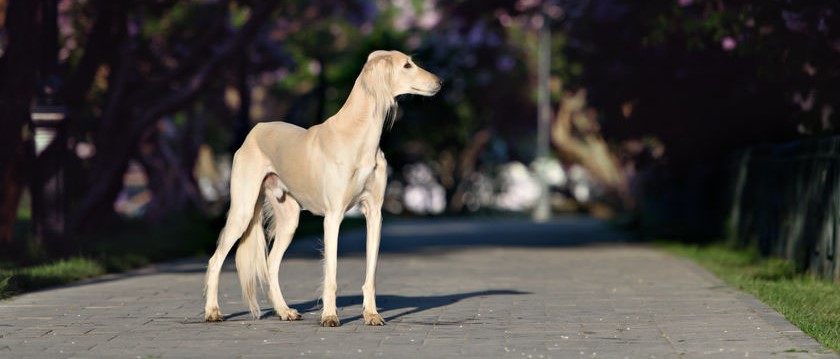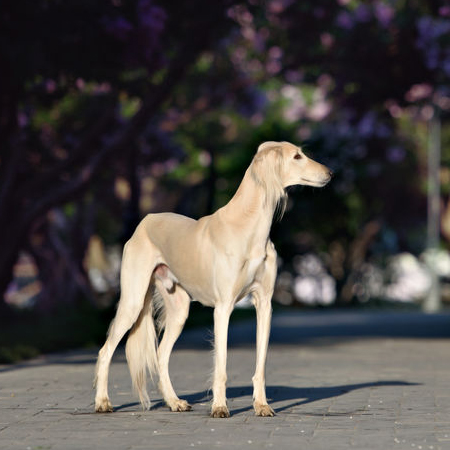Get a GRIHP! on Salukis
This article on Salukis is part of a series to highlight the Big Picture of health, welfare and breeding and to help develop Globally Relevant Integrated Health Profiles (GRIHPs) for many breeds. See IPFD's Get a GRIHP! on Breed Health Initiative. PLEASE NOTE: This installment is just the beginning...we will add further statistics and information as they become available.

Get a GRIHP! on Salukis
Table of Contents
Breed Overview - In a Nutshell
Absracted from the Summary of the Breed-Specific Breeding Program (JTO) for
2014-2018 from the Finnish Saluki Club http://www.saluki.fi/
The Saluki is an ancient breed originated from the Middle-East. The breed has developed over thousands of years to hunt various kinds of game over different terrain. The diversity in the surroundings and hunted game has resulted in different types of salukis: there is great variation in the appearance of a saluki. Function, hunting, has guided the development of the Saluki to its perfection; the Saluki has always been the same. Therefore the main goal in breeding is to preserve, not to improve or change the breed.
The western breeding of saluki began at the end of the 19th century in the UK. The first breed standard was written in 1923. In Finland breeding began in 1949. ... Most western bred salukis descend from 40-45 early imports. Several bottlenecks, inbreeding and popular sires have narrowed the gene pool. However, use of imports and foreign studs has increased and dogs from countries of origin are still available, which has a positive effect in the inbreeding coefficient and diversity. The Society for the Perpetuation of Desert Bred Salukis: at https://desertbred.org is committed to protect all aspects of the genetic diversity of the saluki breed, especially through the perpetuation of registered country of origin Salukis. With the support of the Saluki Club of America, The Society provided the mechanism by which Middle Eastern salukis imported directly to the United States, and their descendants, might be deemed eligible for full entry into the AKC Saluki Stud Book, thereby increasing genetic diversity in the breed.
Saluki is a normally structured, healthy breed. ... Hunting with a saluki is not allowed in Finland, and thus the saluki is regarded as a companion dog. Track racing and lure coursing are good stimulants to compensate the actual hunt and to gather information about the physical hunting skills and instinct. In Finland (2014-2018) 10-15% of salukis acquire a racing license, whereas 35-50% of salukis get a lure coursing license.
Key Health Concerns of this Breed
From the UK: The Saluki or Gazelle Hound Club reports on health surveys:
Three most prevalent (owner reported) fatal health conditions from the survey were:
-
Cancer.
-
Heart disease. The club says: "The actions of the breed clubs and breeders have succeeded in considerably reducing incidence in the last few years."
-
Old age. IPFD note: Old Age is a cause of death only cited by owners, as opposed to veterinarians. However, estimates suggest that Salukis tend to live 12-14 years of age.
Also: "A small number of cases of autoimmune hypothyroidism have been identified over the last five years."
From the Saluki Club in Finland:
"The official database of the Finnish Kennel Club KoiraNet (in English here LINK) is the best place to look for information on the Finnish saluki population. The database contains among others information on the litters born/registered, health information, results from trials and dog shows and different kind of statistics.
The Finnish Saluki Club recommends that all salukis used for breeding have their eyes and hearts (cardiac examinations ) checked in official examinations (please see here LINK for further information on these checks). The official database contains cardiac examinations as from the year 2015.'"
the Finnish JTO (see below)- breed-specific breeding strategy: The most common health problems are allergies and skin problems, tumors, heart diseases and autoimmune diseases. Reported temperament related problems are shyness, separation anxiety and aggression towards other dogs, also housebreaking problems were reported.
What do caretakers of Salukis need to know?
Breeders have long told new owners that Salukis, similar to some other sighthounds can have different 'normal' values for some diagnostic tests, including cardiac (heart) findings, and some blood parameters. Recent research has confirmed reference values in the breeds (see veterinary literatutre references, further below).
From: The Saluki or Gazelle Hound Club (UK). : Saluki complete blood count (CBC)
The Saluki CBC is similar to Greyhounds. These differ from most other breeds. It is a common laboratory test, prior to surgery, and as a diagnostic aid: results here. It is particularly important for your vet to understand the implications on anaesthesia.
Population statistics for Salukis - the trends

The Saluki Archive offers data for Salukis by country. Below are two extracts which indicate the number of Salukis world wide is not high.


Health Statistics
 Agria - Swedish Breed Profiles
Agria - Swedish Breed Profiles
NOTE: Agria Breed Profiles are available in our Downloads sections and via the Saluki entry in our Breeds Database.
 Overall - Salukis are a relatively healthy breed - only slightly increased rate of (one or more) Veterinary Care Events compared to All Breeds, and slightly less than some other hounds.
Overall - Salukis are a relatively healthy breed - only slightly increased rate of (one or more) Veterinary Care Events compared to All Breeds, and slightly less than some other hounds.
 As suggested by breed clubs Salukis have an increased rate of heart and immune problems, in terms of general causes of veterinary care events.
As suggested by breed clubs Salukis have an increased rate of heart and immune problems, in terms of general causes of veterinary care events.
 Specific causes of disease for Salukis show that traumatic injuries are common, and cardiomyopathy is the most common cause under heart conditions. The absence of specific causes that would explain the higher rate of 'immune' conditions, would suggest that there are various diagnoses, however none are very frequent on their own.
Specific causes of disease for Salukis show that traumatic injuries are common, and cardiomyopathy is the most common cause under heart conditions. The absence of specific causes that would explain the higher rate of 'immune' conditions, would suggest that there are various diagnoses, however none are very frequent on their own.

Salukis - Breed-Specific Health Strategies
Piia Kallioinen
Member of the Breeding Committee of The Finnish Saluki Club has graciously provided the English summary of the Finnish JTO - Saluki
Access the file in DWN Downloads at: https://dogwellnet.com/files/file/336-saluki-breeding-strategy-english-summary/
IPFD and the World Small Animal Veterinary Association

Check out the IPFD - WSAVA Meet the Breed article on French Bullldogs.
See our series of articles in the WSAVA Bulletin.

And our IPFD:
References and Resources
Veterinary Literature
-
Seckerdieck M, Holler P, Smets P, Wess G. Simpson's method of discs in Salukis and Whippets: Echocardiographic reference intervals for end-diastolic and end-systolic left ventricular volumes. J Vet Cardiol. 2015 Dec;17(4):271-81. doi: 10.1016/j.jvc.2015.08.002. Epub 2015 Oct 21. PMID: 26476964. Background: "Sighthound breeds are known to have different cardiac sizes and dimensions from other breeds; therefore, breed-specific references are required to avoid misinterpretation of echocardiographic findings. End-diastolic volume (EDV) and end-systolic volume (ESV) reference intervals derived from Simpson's method of discs (SMOD) do not exist for Salukis or Whippets."
-
Giraut S, Häggström J, Koskinen LLE, Lohi H, Wiberg M. Breed-specific reference ranges for standard echocardiographic measurements in salukis. J Small Anim Pract. 2019 Jun;60(6):374-378. doi: 10.1111/jsap.12975. Epub 2019 Jan 31. PMID: 30701551. Clinical significance: This study provides detailed bodyweight-based echocardiographic values in normal Salukis which can be used as reference values.
DogWellNet Resources





 Agria - Swedish Breed Profiles
Agria - Swedish Breed Profiles






Recommended Comments
There are no comments to display.
Please sign in to comment
You will be able to leave a comment after signing in
Sign In Now